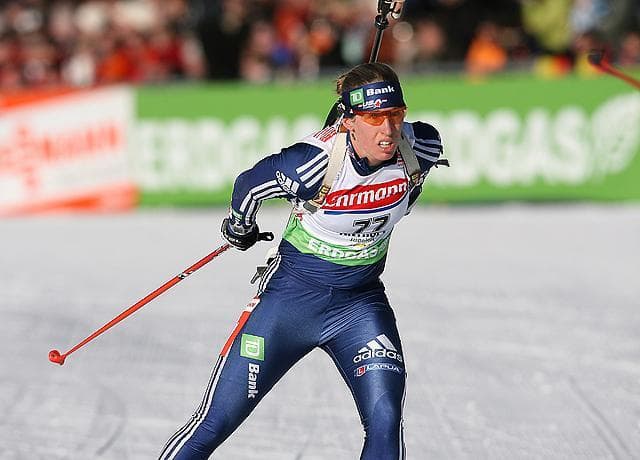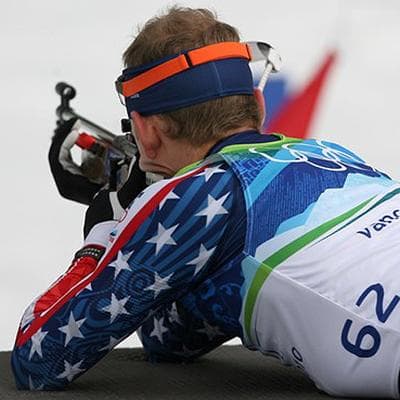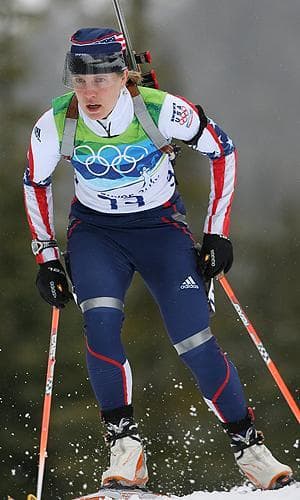Advertisement
U.S. Teams Take Aim At Europe's Biathlon Dominance
Resume
So far at the 2010 Winter Olympics, six gold medals have been handed out in biathlon — a sport that combines cross-country skiing with rifle shooting — to five European nations. That is unsurprising for an event that has long been dominated by the continent.
The United States has never won an Olympic medal in biathlon. But hopes are on the rise among the men's and women's teams.
Though tough weather conditions, making it difficult to shoot and even more difficult to ski, have derailed a few American contenders in Vancouver, Jeremy Teela finished ninth in the 10-kilometer sprint last Sunday — the best Olympic result the U.S. has ever had.
“You never know what you’re going to get, whether rain, snow or sleet, sunshine or ice,” said Lanny Barnes, who also competed through rain in her 7.5-kilometer sprint last Saturday.
Barnes knows. She has competed in biathlon for about 10 years along with her twin sister, Tracy. This is her second Olympic bid. After finishing 23rd in Thursday’s individual 15-kilometer event, she’s looking forward to Tuesday’s relay race.
“Relay is probably my favorite," Barnes said. "Coming from a team sport with soccer that’s kinda my passion, going out there and competing for a team.”
Like many U.S. biathletes, Barnes came to the sport through a chance encounter, as she and her sister competed in various shooting competitions as kids. That is where the sisters bumped into a biathlon coach who worked out of the U.S. Olympic Training Center in Colorado Springs, Colo.

Lanny and Tracy took to the sport despite its physical challenges. Try this: Go outside and run around your house as hard as you can for about a half hour. Then stop and try to thread a needle. That is kind of what biathlon is like.
In her training, Barnes will ski as hard as she can around a track. She will then enter a shooting range and either shoot standing or drop onto her stomach in what is called the prone position. She’ll relax just enough to fire a 22-caliber bullet at five targets. The targets turn white once she hits them.
Competing With Europe
Another who has long been involved with biathlon is Max Cobb, the executive director of the United States Biathlon Association (USBA). He says the first recorded competitions took place in the 1700s between Swedish and Norwegian border patrols as a way to “pass the long winters.” Barnes says it is the most watched winter sport on television in Europe.
“Europeans are crazy about it,” Barnes said. “We’ll get anywhere from 20,000-30,000 spectators at each individual World Cup, even during the week.”
But biathlon in the United States is relatively obscure and American competitors have suffered because of it. The team has historically lacked funding and resources.
However, Cobb says the program began showing promise for an Olympic medal back at the Salt Lake City Games in 2002. “We came pretty close,” he said, “both in Salt Lake and then really close in Torino with Jay Hakkinen missing a medal by a split bullet in an individual 20-kilometer event.”
Cobb says those results ushered in a new era of biathlon in America. The USBA hired top European coaches and the United States Olympic Committee (USOC) increased its support from $250,000 to $1 million a year.
Now the men’s team has four seasoned Olympians and the women’s team is coming into their own. Cobb won’t make predictions for the remaining Vancouver Games, but he is confident that they will be strong medal contenders four years from now at the Olympics in Sochi, Russia.

“We’ve got some wonderful junior athletes coming along on the men’s side,” Cobb said. “And we’ve got good potential on the women’s side to develop that as well.”
This development angle is key, as success in biathlon takes years of training. Haley Johnson, who is currently competing in Vancouver, was introduced to the sport in 1996. She is now 28 and feels that her career is on the upswing. Johnson says winning an Olympic medal would mean more dollars from the USOC — money she says would be used to help connect kids with biathlon.
“We’re a program that it’s worth for them to invest in,” Johnson said. “With that money the biggest thing the USBA would be excited to do is to invest into more grassroots programs because it’s a sport that’s difficult to enter in at an older age.”
However, a simple, but major barrier for getting American kids into biathlon is the small number of cross-country courses with shooting ranges.
Cobb says that is why USBA is rolling out a laser biathlon program this year, in which any ski club can set up a laser beam range next to its cross-country ski trail. A ski club in Hanover, Conn. is currently testing those laser rifles with youth participants.
In the meantime, the present group will go for America’s first biathlon medal in Sunday's men’s and women’s Mass Start races, in Tuesday’s 6-kilometer women’s relay and in the men’s 7.5-kilometer relay on Friday.
This program aired on February 19, 2010.